How To Identify Your Vintage / Antique Wood Golf Clubs And Irons
Use the examples below to compare and identify your clubs
Woods: Original Name
-
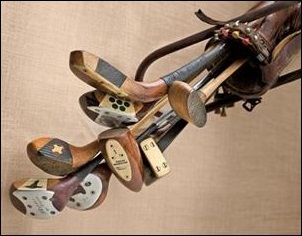 No.1
Wood; > Driver, Play Club
No.1
Wood; > Driver, Play Club - No.2 Wood; > Brassie
- No.3 Wood; > Spoon Brassie
- No.4 Wood; > Wood Cleek, Baffy
Putter: Blank
Irons: Original Name
- No.1; > Driving Iron, Cleek
- No.2; > Cleek, Mid Iron
- No.3; > Mid-Mashie
- No.4; > Jigger, Mashie Iron
- No.5; > Mashie
- No.6; > Spade Mashie
- No.7; > Benny
- No.8; > Mashie Niblick
- No.9; > Pitching Niblick
Wedge > Niblick, Baffing Spoon
Hickory Shaft Wood Golf Clubs "Woods"
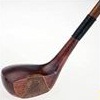 Driver
- Play Club: The Play Club Driver was invented in the 1890's and are very scarce today.
They came in a wide range of designs with lofts ranging from 7 to 13 degrees. The head sizes
and shapes include something about the size of a modern 5 Wood, on up to sizes much meatier
like modern drivers. Of all the different shapes of heads to be found, the large headed,
pointed toe, shallow faced woods are typical of the style that the Scottish makers were
producing in the 1910's and 1920's. Variations like this were also produced in the U.S.,
but with a more rounded toe. The big heads with the deep faces are primarily American manufactured,
most notably by Wilson. The midsize heads are similar to the Macgregor woods of the 50's
& 60's and are some of the most playable and Collectible wood golf clubs.
Driver
- Play Club: The Play Club Driver was invented in the 1890's and are very scarce today.
They came in a wide range of designs with lofts ranging from 7 to 13 degrees. The head sizes
and shapes include something about the size of a modern 5 Wood, on up to sizes much meatier
like modern drivers. Of all the different shapes of heads to be found, the large headed,
pointed toe, shallow faced woods are typical of the style that the Scottish makers were
producing in the 1910's and 1920's. Variations like this were also produced in the U.S.,
but with a more rounded toe. The big heads with the deep faces are primarily American manufactured,
most notably by Wilson. The midsize heads are similar to the Macgregor woods of the 50's
& 60's and are some of the most playable and Collectible wood golf clubs.
Play Club Drivers were used for trajectory and longer rolling distances that characterized these clubs for shots into the wind and holes with more forgiving fairways. American makers included Macgregor, Wilson, Spalding, and Wright & Ditson. Scottish manufactured ones are good finesse clubs with great feel and balance.
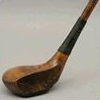 Brassie:
The Brassie was the high use work horse of old wooden golf sets. It got it's name due to
the fact that they usually had a sole plate made of brass, and were intended to be used
for hitting the ball off the ground which requiring a durable soleplate to give them some
extra protection. The Brassie was also commonly used for tee shots and gave the players
more control and accuracy with a minimal distance loss. Most don't have the name stamped
on them but, generally wood clubs with a sole plate and somewhere between 12 and 17 degree
lofts are Brassie's. Another variant was called the Driving Brassie, and normally had a
large head, deep face plus loft and shaft length of a driver. The stout shafts made the
Driving Brassie a great driving clubs that would stand up to a lot of abuse...
Brassie:
The Brassie was the high use work horse of old wooden golf sets. It got it's name due to
the fact that they usually had a sole plate made of brass, and were intended to be used
for hitting the ball off the ground which requiring a durable soleplate to give them some
extra protection. The Brassie was also commonly used for tee shots and gave the players
more control and accuracy with a minimal distance loss. Most don't have the name stamped
on them but, generally wood clubs with a sole plate and somewhere between 12 and 17 degree
lofts are Brassie's. Another variant was called the Driving Brassie, and normally had a
large head, deep face plus loft and shaft length of a driver. The stout shafts made the
Driving Brassie a great driving clubs that would stand up to a lot of abuse...
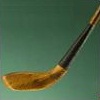
Spoon Brassie: The Spoon, Spoon Brassie or Brassie Spoon as they were variously called, compare to something between a modern 3 to 5 wood in loft, and have 15 to 22 degrees of loft. Like the Drivers and Brassie's, Spoons Brassie's came in all shapes and sizes. Some of these clubs are the easiest clubs to hit and can include surprisingly large heads. Shallow, elongated toe versions are also great hitting clubs, but due to there small size they happen to be prone to breaking easily so it can be hard to find these wood golf clubs for sale in good enough condition to restore or use.
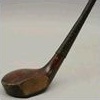
Wooden Cleek: The Wooden Cleek is in the generally range of a contemporary 4 to 6 Wood with a loft of 18 to 25 degrees. The Wooden Cleek is a natural substitute for the more-difficult-to-hit mid iron shots since it made these shots easier to hit. It was also a great choice to use as a fairway wood that is easy to hit from tight lies where the ball is sitting on bare dirt, very short grass with little fluff beneath the ball. The club head of a Wooden Cleek can be narrower than a standard fairway wood and comes close to resembling a modern-day hybrid wood.
 Bulldog:
The Bulldog style fairway wood is a very difficult club to find. The bulldog is a wonderful
utility and trouble club, The bulldog has a compact head with a very rounded soleplate and
a loft in the 18 to 24 degree range. The typical head on a bulldog is quite small at only
about twice the size of a golf ball. It's a great club to use for getting the ball out of
some very bad lies. These clubs were generally not made in large quantities or for any length
of time which means that these old age wood golf clubs are
very scarce and hard to find in a playable condition.
Bulldog:
The Bulldog style fairway wood is a very difficult club to find. The bulldog is a wonderful
utility and trouble club, The bulldog has a compact head with a very rounded soleplate and
a loft in the 18 to 24 degree range. The typical head on a bulldog is quite small at only
about twice the size of a golf ball. It's a great club to use for getting the ball out of
some very bad lies. These clubs were generally not made in large quantities or for any length
of time which means that these old age wood golf clubs are
very scarce and hard to find in a playable condition.
Baffy: The Baffy is a small headed, steeply lofted wooden club no longer in use. It was developed from the baffing spoon. The modern equivalent would be the number four or five wood. It is very similar to the Bulldog, but somewhat larger, and it was probably used to get the ball out of very bad lies. The baffing spoon (also "baffie, baffy") archaic term for an approach wood or lofted wood was probably used to avoid trouble such as a water hazard by hitting the ball to a safe area.
The Brassie Iron and Wooden Iron are the fairway wood equivalents of the Mid-Iron.
Woods - Wooden Headed Clubs
- Long Nose Golf Clubs (pre-1885)
- Transitional Golf Woods (1885 - 1890)
- Bulger Golf Woods ( Scared or Splice Neck 1895 - 1910 )
- Bulger Golf Woods ( Socket Neck 1910 - 1935 )
- Aluminum Head ( 1895 - 1935 )
Irons - Smooth Face & Pattern face
- Early Golf Irons ( pre 1850 )
- Smooth Face Irons ( 1850 - 1910 )
- Pattern Face Irons ( 1910 - 1935 )
Putters - Smooth Face & Pattern face
- Steel Blade Head Smooth Face 1890's
- Steel Blade Head Pattern Face
- Aluminum Head (1895 - 1935 )
- Wooden Headed ( Splice join pre-1900 )
- Wooden Headed ( Socket join post 1900 )
Hickory Shaft Wood Golf Clubs "Irons"
Cleek - Driving Cleek: The best known type of Cleek is the Driving Cleek, which has a small head and a loft of about 19 degrees. The cleek has a specific head shape with a shallow face that is relatively long with some taper from heel to toe. Other types of Cleeks include the Light Cleek, the Lofting Cleek (also known as the Jigger), the Sammy (a mongrel version) and the Lofter. It was commonly used from the mid 1800's to about 1910.
Driving Iron: The Driving Iron was used for driving the ball off the tee as well as hitting from the fairway. Driving Irons generally have an Iron shaped head, but are also found with tall toe similar in height to a Mashie. Tall toe versions look to be special utility irons used in place of a driver. The Driving Iron and the Driving Mashie were used from about 1910 on, as player found them to be an alternative to the harder to hit driving cleek.
Driving Mashie: The Driving Mashie is a stout iron used off the tee and for long aggressive shots from the fairway. It gets its name from the Mashie head shape and includes a short head length and pronounced taper outward at the toe. It's low loft face allowed better players to get the ball out of thicker lies that longer headed clubs couldn't get through. Generally Driving Mashie's have a fairly stout shaft to accommodate this type of use.
Push Iron: This club was made specifically for the "Push Shot" which was then a different effect than the current meaning. This shot in the past put considerable backspin on the ball for more bite on the green. Today the Push is caused by an in-to-out swing path from the club. Push Irons are quite rare and very Collectible. In a club set it should fit in between the driving iron and the mid-iron.
Sammy: The Sammy is another specialty club that fit in between the driving iron and the mid-iron with it's loft and length. It consisted of a Cleek head shape, rounded back, and driving iron length shaft. The lower center weight of the head made ball trajectory higher than equivalent clubs with a different head shape. It combined a high mid-iron ball flight and long driving iron distance. As another scarce and hard to find club, it is also highly Collectible for wood golf club values.
Mid-Iron: The Mid Iron was a commonly included club in any basic club set during the early 20th century. This clubs origin dates back to the 1890's and produced a medium long length shot that served general duty. It could be used for many different types of shots that required a lower trajectory flight along with a good run. It was a highly recommended club for learning to play the game since it could be used in many different situations.
Mashie Iron: The Mashie Iron often has identical specifications to the Mid-Iron. It may have often been used as a mid-iron in situations were the mashie head shape was better suited. It was occasionally used by better players as a utility club during the late 20's into 30's. The Mashie Iron was the club used by Bobby Jones for his famous shot out of a fairway trap to win the 1926 British Open.
Approaching Cleek: This club debuted in the 1890's and it's cleek shaped head made it a great club to use for approach shots to the green. Most of these clubs are made with a musselback and are modified versions of the jigger. It is a powerful club with great feel due to the increased weight behind the sweet spot on this musselback design. The Approaching Cleek is a moderately scarce utility club that could suit many players games well.
Iron: The Iron was a common club from the 19th century that was used to make medium length approach shots tp the green. 20th century scored face Irons are roughly equivalent to the mid-iron but with a slightly milder loft. This may have made them a good club to be used as an in-between club for something between the mashie and mid-iron. Some players carried both an iron and a mid-iron in their golf bag.
Mongrel Mashie: The Mongrel Mashie is a utility club designed to be an in-between club for the mashie and mid-iron. The term Mongrel was used interchangeably with "freak" to describe specialty clubs. The Mongrels head shape is very similar to the shape of an Iron with little resemblance to the Mashie head shape. It is very similar in performance to a wood shafted 3-Iron and could have been the predecessor to that club.
Jigger - Lofting Cleek: Introduced just before the turn of the century, the Jigger or Lofting Cleek offered a laid back face that made it a good choice for approach shots that were mostly carry. This club was also intended to fit in between the Mid-iron and Mashie for full shots. It was also a good choice for when cut down to use for chip and pitch shots. The shallow face made them a challenging club to hit for less experienced player.
Mashie: The Mashie was introduced in the 1880s and most likely started the Iron club revolution. With a shorter and deeper head shape than the Cleek or Iron heads, it had more taper from heel to toe giving it a hatchet like shape. This club was used for the majority of the shots making it the most popular iron headed club in a players bag. It was used for a wide variation of range from its maximum distance, down to the shortest approach shots.
Spade Mashie: The Spade mashie is easily identified by its oversized head shape with added loft. The design made it a good club for hitting out of fluffy lies to avoid going under the ball. The Spade can be used to fill a full shot distance between the mashie and mashie niblick though a little challenging because of its size. These clubs are generally made with a lighter head weight, presumably to compensate for the club head size which can make them squirrelly
Benny: The Benny is a type of Mashie Niblick that was developed by Ben Sayers of North Berwick. Its distinct head shape is very similar in style to a Mashie but with more of a Spade Mashie loft. It can be used as an alternative club to fill the gap in spacing between those clubs. With a more moderate sized head it can be easier to hit then the Spade Mashie. It is also a scarce club but well worth finding for a play set.
Mashie Niblick: The Mashie Niblick is a well lofted club intended to fit in between the Mashie and the Niblick. It is a great club for chipping, pitching, and full lofted approach shots. Made in a very wide assortment of shapes and sizes the most popular best described as egg shaped, its invention was attributed to the Foulis' of Chicago, since they patented the original shape for the club head back in 1903.
Niblick - Sand Iron: The Niblick is the most lofted club of the hickory wood golf club era, and comparable to the contemporary Sand Wedge. It was used for the same purposes, lofted approaches, bunker shots, avoiding obstacles and extricating the ball from other bad lies. It can be found in a wide range of lofts comparing from a pitching wedge to a lob wedge. It can be found in a wide range of styles and club head sizes from very small to a giant eight inches in diameter.
Hickory Shaft Wood Golf Clubs "Putters"
Putter - Blank: This is one of the few clubs whose name and purpose is still recognizable, though there are references to calling it a Blank in the early days. Putters are available in an incredible variety of shapes, styles and materials. Putters are most commonly found with a blade style head though many wood headed putters tend to be the most Collectible. With most of them made from forged steel, they can have a great balance and feel. It is common to find them with up to 10 degrees of loft since they were designed and milled to compensate for playing the old style greens that were often slower with longer grass. These were, and still are, the clubs that get experimented with the most.
